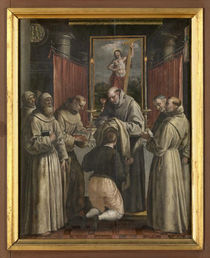The Catholic Defender: Saint Cornelius
- Donald Hartley

- Sep 15
- 3 min read

Saint Cornelius was the bishop of Rome from 6th or 13th March 251 until his martyrdom in June 253. He was pope during and following a period of persecution of the church, while a schism occurred over how repentant church members who had practiced pagan sacrifices to protect themselves could be readmitted to the church. He agreed with Cyprian of Carthage that those who had lapsed could be restored to communion after varying forms of Reinitiation and Penance.
St. Cornelius was a Priest that strongly believed in the gift of confession. In his time there were many Christians who denounced Christianity to Emperor Decius in order to be spared their lives. The Church leaders of their time thought they could never be brought back into the church after such behavior.
Cornelius's saintly name means "battle horn", and he is represented in icons by a pope either holding some form of cow's horn or with a cow nearby.
But Cyprian called him a martyr and later accounts said that Cornelius had been beheaded. He was buried at Rome in the crypt of Lucina, where his tomb can still be seen with the inscription Cornelius Martyr.
Cornelius is the patron saint of earache sufferers (perhaps because of his arguments with Novatian), domestic animals, cattle and, unsurprisingly, the town of Kornelimünster.
There was no pope for 14 months after the martyrdom of Saint Fabian because of the intensity of the persecution of the Church. During the interval, the Church was governed by a college of priests. Saint Cyprian, a friend of Cornelius, writes that Cornelius was elected pope “by the judgment of God and of Christ, by the testimony of most of the clergy, by the vote of the people, with the consent of aged priests and of good men.”
The greatest problem of Cornelius’s two-year term as pope had to do with the Sacrament of Penance and centered on the readmission of Christians who had denied their faith during the time of persecution. Two extremes were finally both condemned. Cyprian, primate of North Africa, appealed to the pope to confirm his stand that the relapsed could be reconciled only by the decision of the bishop.
In Rome, however, Cornelius met with the opposite view. After his election, a priest named Novatian (one of those who had governed the Church) had himself consecrated a rival bishop of Rome—one of the first antipopes.
He denied that the Church had any power to reconcile not only the apostates, but also those guilty of murder,
adultery, fornication, or second marriage! Cornelius had the support of most of the Church (especially of Cyprian of Africa) in condemning Novatianism, though the sect persisted for several centuries. Cornelius held a synod at Rome in 251 and ordered the “relapsed” to be restored to the Church with the usual “medicines of repentance.”
The friendship of Cornelius and Cyprian was strained for a time when one of Cyprian’s rivals made accusations about him. But the problem was cleared up.
A document from Cornelius shows the extent of organization in the Church of Rome in the mid-third century: 46 priests, seven deacons, seven subdeacons. It is estimated that the number of Christians totaled about 50,000. He died as a result of the hardships of his exile in what is now Civitavecchia.
It seems fairly true to say that almost every possible false doctrine has been proposed at some time or other in the history of the Church. The third century saw the resolution of a problem we scarcely consider—the penance to be done before reconciliation with the Church after mortal sin. Men like Cornelius and Cyprian were God’s instruments in helping the Church find a prudent path between extremes of rigorism and laxity. They are part of the Church’s ever-living stream of tradition, ensuring the continuance of what was begun by Christ, and evaluating new experiences through the wisdom and experience of those who have gone before.





















Comments